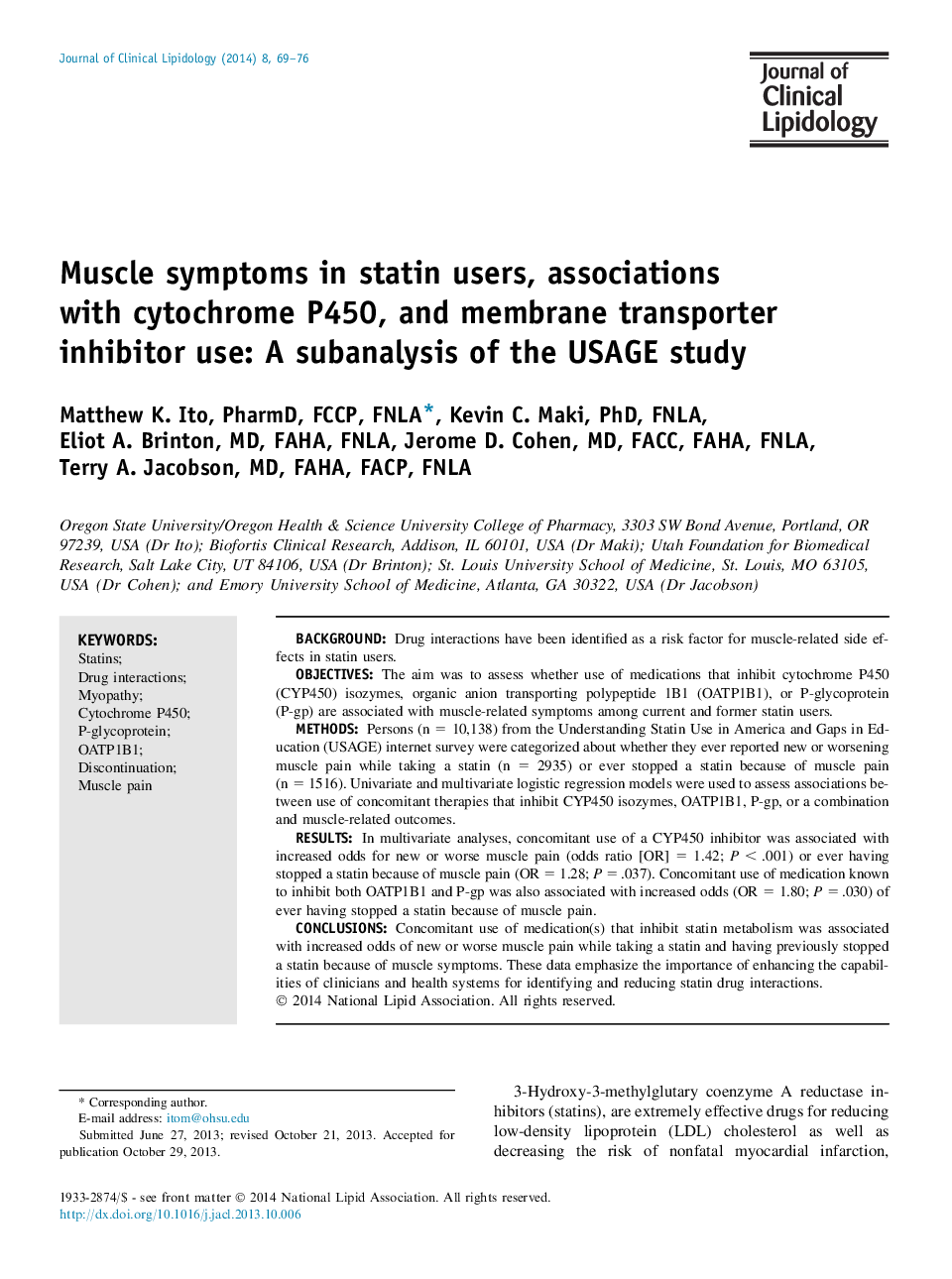| کد مقاله | کد نشریه | سال انتشار | مقاله انگلیسی | نسخه تمام متن |
|---|---|---|---|---|
| 2965850 | 1178783 | 2014 | 8 صفحه PDF | دانلود رایگان |

► Drugs that reduce statin metabolism by inhibiting cytochrome P450 (CYP450) isozymes or interfering with drug transporters, such as organic anion transporting polypeptide 1B1 (OATP1B1) and P-glycoprotein (P-gp), can lead to increased systemic exposure of the statin and increase risk of myopathy.
► We hypothesized that among USAGE participants that the use of concomitant medication(s) that inhibit CYP450 isozymes, OATP1B1, or P-gp alone or in their combination would be associated with increased odds of new or worsening muscle pain while taking a statin or ever having stopped a statin because of muscle pain.
► In multivariate analyses, concomitant use of a CYP450 inhibitor was associated with increased odds for new or worse muscle pain (OR = 1.42; P < .001) or ever having stopped a statin because of muscle pain (OR = 1.28; P = .037). Concomitant use of medication known to inhibit both OATP1B1 and P-gp was also associated with increased odds (OR = 1.80; P = .030) of ever having stopped a statin because of muscle pain.
► Concomitant use of medication(s) that inhibit statin metabolism was associated with increased odds of new or worse muscle pain while taking a statin and having previously stopped a statin because of muscle symptoms.
► These data emphasize the importance of enhancing the capabilities of clinicians and health systems for identifying and reducing statin drug interactions.
BackgroundDrug interactions have been identified as a risk factor for muscle-related side effects in statin users.ObjectivesThe aim was to assess whether use of medications that inhibit cytochrome P450 (CYP450) isozymes, organic anion transporting polypeptide 1B1 (OATP1B1), or P-glycoprotein (P-gp) are associated with muscle-related symptoms among current and former statin users.MethodsPersons (n = 10,138) from the Understanding Statin Use in America and Gaps in Education (USAGE) internet survey were categorized about whether they ever reported new or worsening muscle pain while taking a statin (n = 2935) or ever stopped a statin because of muscle pain (n = 1516). Univariate and multivariate logistic regression models were used to assess associations between use of concomitant therapies that inhibit CYP450 isozymes, OATP1B1, P-gp, or a combination and muscle-related outcomes.ResultsIn multivariate analyses, concomitant use of a CYP450 inhibitor was associated with increased odds for new or worse muscle pain (odds ratio [OR] = 1.42; P < .001) or ever having stopped a statin because of muscle pain (OR = 1.28; P = .037). Concomitant use of medication known to inhibit both OATP1B1 and P-gp was also associated with increased odds (OR = 1.80; P = .030) of ever having stopped a statin because of muscle pain.ConclusionsConcomitant use of medication(s) that inhibit statin metabolism was associated with increased odds of new or worse muscle pain while taking a statin and having previously stopped a statin because of muscle symptoms. These data emphasize the importance of enhancing the capabilities of clinicians and health systems for identifying and reducing statin drug interactions.
Journal: Journal of Clinical Lipidology - Volume 8, Issue 1, January–February 2014, Pages 69–76